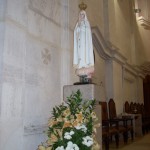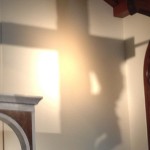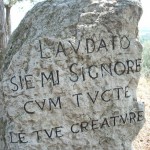As Church and as individuals, we are always neither here nor there.
Up early on the West Coast, getting ready to fly back to Dayton, my heart (as always) in ribbons at leaving family for “family,” home of record for the place to which God inexplicably called me. I’m hearing Neil Diamond’s “I Am, I Said” in my head:
Nowadays I’m lost between two shores:
LA’s fine, but it ain’t home,
New York’s home, but it ain’t mine no more.
Switch those around and replace New York with Dayton, and you’ve got my morning restlessness.
It’s a restlessness that’s endemic to humanity, as Augustine so beautifully reminds us. And because the Church is made up of restless humans, she too is restless and torn. Fidelity to the past, yearning for the future. Stability, pilgrimage. Holding on, letting go.
The passing this weekend of Cardinal Carlo Martini, retired Archbishop of Milan, spotlighted this sense of being lost between two shores. In an interview published posthumously, Cardinal Martini—perhaps among the last of the prophetic voices of the Vatican II Church—chafed at what he saw as an ecclesial distrust of the Holy Spirit that has led to a hardening of the Church’s arteries, a longing to live in the past. “The Church is stanca (exhausted),” Cardinal Martini famously said, and “200 years out of date.”
Some days, in spite of my own turn to the traditional (a turn that goes unacknowledged by my most dissatisfied readers, and too acknowledged by my liberal friends), I am with the late Cardinal completely. I’m impatient with the slowness of the mills of the Vatican, intolerant of correction without compassion—even as I dish it out myself. But Fr Steve Grunow, writing at Fr Barron’s Word on Fire blog, has a longer view worth considering. It is a view that disagrees with Cardinal Martini’s take, but never impugns his faith or his love of the Church:
Perhaps what Cardinal Martini meant when he remarked that the Church was “200 years out of date” was that it continues to fail to fully accept the kind of world that was birthed during that particular age of European history. He might have had in mind the best of what modernity has to offer- the promises of rights for those who formally had little or none. Maybe in his estimation, the revolutionary fervor and sense of liberty that gave rise to the nation state has not been as of yet fully appreciated and appropriated by the Church. He believed that the Church should do more to represent within its own structures the kind of world of which 1812 was an overture. As the romantic symphony of modernity has given way to the discordant notes of the post-modern, it seems to me, contrary to the late Cardinal’s perception, that the culture and the Church benefits more from a certain measure of resistance to the modern, rather than our assimilation into it.
Do read the whole piece. And then contemplate the peculiar seeming-irony of Cardinal Martini’s funeral Mass, celebrated—as the Mass has been for centuries in his former diocese of Milan—according to the Ambrosian Rite. A voice of the future laid to rest, beautifully, with the voices of the past. Fr Michael Duffy shares the liturgical loveliness here.
Voters, in this contentious season, are also lost between two shores. Elizabeth Scalia’s column in First Things today builds a lighthouse and sounds a foghorn. Apropos of my own recent skirmish in the blog wars, I am taking Elizabeth’s advice to let these words from The Imitation of Christ (part of today’s Office of Readings) be my mantra as I let the din of words be swallowed up in the white noise of jet engines:
How can anyone be aroused by empty talk if his heart is subject in the truth to God? The whole world cannot swell with pride the man who is subject to truth; nor will he be swayed by the flattery of all his admirers, if he has established all his trust in God. For those who do all the talking amount to nothing; they fail with their din of words, but the truth of the Lord endures for ever.
Finally, I can’t leave LA on this, the 231st birthday of the City of Angels (and not coincidentally, the quite-a-bit-fewer-years birthday of my teacher and friend Eloise Klein Healy, the person who did the most to make me a writer, but don’t blame her), without noting just how easy it is to see the two-shoreness of the Church here. Sunday marked the 10th anniversary of the Cathedral of Our Lady of the Angels. Known to many (and not entirely unfairly) as Taj Mahony, the cathedral’s aggressive modernity soars over the downtown freeways, a seeming break from the past. But the place is filled with life and vibrancy, and it is the life and vibrancy of LA’s—and the US Church’s past and future, which speaks and sings and celebrates and evangelizes in Spanish. Archbishop Jose H. Gomez marked the significance of this fusion of past and future on Sunday when he dedicated the cathedral’s Chapel of Our Lady of Guadalupe, enshrining in a reliquary the only remnant of San Juan Diego’s tilma, which bears the miraculous image of the Mother of God, in the United States. You can see the ceremony (in Spanish) here.
It’s appropriate to sing to the City of Our Lady, Queen of the Angels of the Porciuncula on this day of her nativity the “Mexican happy birthday song”—which is actually a hymn from the Matins (in Spanish, mañanitas) for the Feast of Our Lady of Guadalupe.
Estas son las mañanitas, que cantaba el Rey David. Hoy por ser día de tu santo, te las cantamos a ti.
Despierta mi bien despierta mira que ya amaneció. Ya los pajaritos cantan. La luna ya se metió
Que linda está la mañana en que vengo a saludarte. Venimos todos con gusto y placer a felicitarte.
Ya viene amaneciendo. Ya la luz del día nos dio. Levántate de mañana. Mira que ya amaneció.
These are the lovely little psalms that were sung by King David. Today we sing them to a loved one who happy will be.
Wake up this early morning and the sun you will see. As the moon leaves us this morning all the birds they will sing.
How beautiful is the morning that I come to share with you. We all come in celebration of this special day just for you.
The day it is a dawning and the light of day has come. Awaken early this morning to see all that we have done.
All my bags are packed, I’m ready to go. Regrettable as it is, bilocation only comes with a state of advanced Gospel living I have no hope of attaining. So I—and my Church—will continue to find ourselves neither here nor there, between two shores but never really lost. For the One who calls us walks—or limps, or races, or rides an LA bus or a plane to Dayton—beside us always. Praise God.












